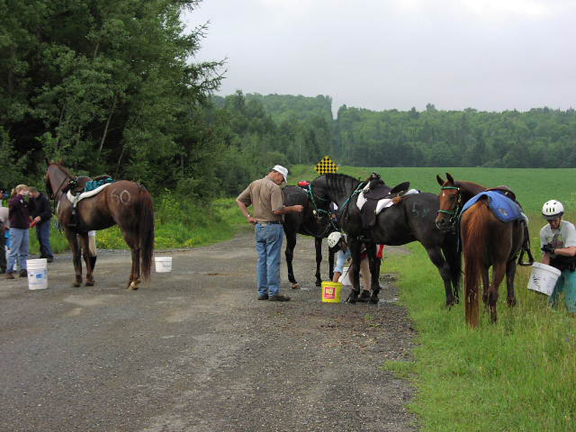Pit Crewing - The Job Description
Pit Crewing - The Job Description
A good pit crew, endurance riders say, is critical to their success. There may be as many as ten "holds" in a hundred-mile race. At each hold, it's the job of the pit crew to help refresh the horse and fortify it for the next leg of the journey.
A pit crew often arrives the day before the ride to scout the location of each hold area, check the availability of water, and decide where they'll set up their gear. On long stretches between holds, they'll stake out road crossings where they'll intercept the rider to provide water, information, and encouragement.
There are two kinds of holds in a race: mandatory holds, where incoming horses must wait for a specified period before veterinarians check their pulse, respiration, and soundness; and optional holds, also known as "vet gates," where riders and crews decide when their horses are ready to be tested. In either case, if the veterinarians feel that a horse doesn't meet all the criteria for soundness - or that he would be dangerously stressed if allowed to continue - They'll eliminate him. If they feel his condition is marginal, they'll probably check him again in ten minutes before making a decision.
As soon as their horse arrives at the hold, the pit crew springs into action. Members check the horse's pulse and respiration recovery rates, time capillary refill, and evaluate dehydration and gut sounds. They correlate the appearance of a horse with his physical signs - and recognize significant changes.
Besides wielding stethoscope, thermometer, and watch, the crew must be ready at each hold with electrolytes, hay, feed and gallon upon gallon of water - tepid for the horse's body, cold for his legs. They go to work immediately, trying to coax elevated pulse and respiration levels down quickly and looking after fatigued muscles, cramps, sore backs, or trail injuries.
Crew also carry extra girths, saddle pads, blankets, and bridles; know precisely where everything is - in spite of frequent packing and repacking; maintain additional water supplies in large tanks on their pickup trucks; and make emergency repairs if needed.
While the rider stretches weary, cramped muscles and perhaps eats or drinks, the crew loosens the girth. The saddle doesn't come off until the back has cooled a little and normal circulation returns to the area. As one crew member monitors pulse and respiration, another sponges the horse's legs, neck, and chest, and offers a drink, a bit of hay, and - at the rider's discretion- electrolytes.
If pulse and respiration rates do not respond to drinking and sponging, the crew person monitoring these functions may try other strategies. Sometimes the offer of a carrot or apple has a soothing effect. Cold water applied directly to the jugular, chest, and front legs speeds cooling in a very hot horse. In chilly weather, blanketing may be necessary.
By turns, crew members walk the horse to keep him from becoming stiff and sore, let him stand and rest, and offer water, feed, and hay. Every two or three minutes, they recheck his vital signs. In conference with the rider, they decide when to present the horse for his vet check: too soon and they risk and additional ten-minute forced hold or even disqualification; too late and they've wasted precious time.
If the horse passes the vet check, the crew continues to take care of him and his rider until it's time to tack up. They supply a dry saddle pad, give horse and rider gear a final check, and provide a cheering section as their team disappears down the trail once again. When a horse is eliminated and ride officials send a request to the base camp for a trailer, the pit crew provides assistance for the horse and comfort for the rider until the trailer comes. Then crew members pack their equipment one last time, load the truck and start making plans for their next campaign.

- Log in to post comments
